Managing Moist Forests of the Pacific Northwest United States for Climate Positive Outcomes
Abstract
1. Introduction
2. Forest Carbon Life Cycle Accounting Considerations and Areas of Scientific Debate
2.1. On-Site Forest Carbon Pools
2.2. Off-Site Forest Carbon Pools
2.3. Substitution
2.4. End of Life
2.5. Carbon Carry-Over
2.6. Leakage
3. Climate Change Impacts and Uncertainty in Forest Management
4. Climate Smart Forestry as an Adaptive Management Approach
5. Takeaways for the Moist Forests of the Pacific Northwest
5.1. Managing Trade-Offs between Extended Rotations and Short-Term Wood Supply
5.2. Land Use: Keeping Forests as Forests
5.3. Considering the Role of Forests in Pacific Northwest Climate Policy
5.4. Forest Carbon Incentive Program
6. Conclusions
Recommended Strategies for Optimizing Climate Outcomes from Forest Management
- Develop targets for expanding forest carbon stocks, segmented by ecoregion and ownership. Emphasize storage in ecosystems with high ecological potential and lower risk of losing carbon through climate driven disturbance.
- Maintain the forestland base by employing ‘No net loss of forests’ or ‘no net loss of forest carbon’ policies.
- Maintain a mosaic of age classes across the forest landscape to balance robust growth rates, production of durable wood products, the conservation of old forests, and a gradual transition to older forest age-classes.
- Build wood product and carbon markets, and necessary wood product infrastructure, to move toward longer rotation forestry (50–90 years) in the moist forest region.
- Mitigate potential leakage through comprehensive policy design and careful implementation.
- Differentiate forest management and product pathways that increase the carbon carryover from on-site to off-site carbon pools. Such pathways should be encouraged and paired with long-lived building systems that displace GHG intensive products.
- Align economic incentives (tax breaks, loan guarantees, grants, etc.) to overcome barriers to realizing the most carbon beneficial forest management and wood product pathways.
- Focus on forest practices that mitigate GHG emissions while enhancing adaptive capacity.
- Increase retention at harvest (e.g., leaving wider riparian buffers, leaving groups of standing live and dead trees).
- Expand investments in forest resilience programs to minimize risk of high severity wildfire and reduce climate driven forest mortality, and associated carbon stock loss.
- Employ principles of adaptive governance in state forest practices acts to respond to climate change impacts and build forest carbon stores.
Supplementary Materials
Author Contributions
Funding
Conflicts of Interest
References
- Pan, Y.; Birdsey, R.A.; Fang, J.; Houghton, R.; Kauppi, P.E.; Kurz, W.A.; Ciais, P. A large and persistent carbon sink in the world’s forests. Science 2011, 333, 988–993. [Google Scholar] [CrossRef] [PubMed]
- Bellassen, V.; Luyssaert, S. Carbon sequestration: Managing forests in uncertain times. Nature 2014, 506, 153–155. [Google Scholar] [CrossRef] [PubMed]
- United States Environmental Protection Agency (EPA). Inventory of US Greenhouse Gas Emissions and Sinks. Available online: https://www.epa.gov/sites/production/files/2018-01/documents/2018_complete_report.pdf (accessed on 5 October 2018).
- Melillo, J.M. Climate Change Impacts in the United States: US National Climate Assessment. Available online: http://nca2014.globalchange.gov/ (accessed on 10 June 2018).
- Van Mantgem, P.J.; Stephenson, N.L.; Byrne, J.C.; Daniels, L.D.; Franklin, J.F.; Fulé, P.Z.; Veblen, T.T. Widespread increase of tree mortality rates in the western United States. Science 2009, 323, 521–524. [Google Scholar] [CrossRef] [PubMed]
- Cameron, D.R.; Marvin, D.C.; Remucal, J.M.; Passero, M.C. Ecosystem management and land conservation can substantially contribute to California’s climate mitigation goals. Proc. Natl. Acad. Sci. USA 2017, 114, 12833–12838. [Google Scholar] [CrossRef] [PubMed]
- Griscom, B.W.; Adams, J.; Ellis, P.W.; Houghton, R.A.; Lomax, G.; Miteva, D.A.; Woodbury, P. Natural climate solutions. Proc. Natl. Acad. Sci. USA 2017, 114, 11645–11650. [Google Scholar] [CrossRef] [PubMed]
- Schmalensee, R.; Stavins, R. Lessons Learned from Three Decades of Experience with Cap-and-Trade (No. w21742); National Bureau of Economic Research: Cambridge, MA, USA, 2015. [Google Scholar]
- Anderson, C.M.; Field, C.B.; Mach, K.J. Forest offsets partner climate-change mitigation with conservation. Front. Ecol. Environ. 2017, 15, 359–365. [Google Scholar] [CrossRef]
- Heath, L.S.; Smith, J.E.; Woodall, C.W.; Azuma, D.L.; Waddell, K.L. Carbon stocks on forestland of the United States, with emphasis on USDA Forest Service ownership. Ecosphere 2011, 2. [Google Scholar] [CrossRef]
- Woodbury, P.B.; Smith, J.E.; Heath, L.S. Carbon sequestration in the US forest sector from 1990 to 2010. For. Ecol. Manag. 2007, 241, 14–27. [Google Scholar] [CrossRef]
- Smithwick, E.A.; Harmon, M.E.; Remillard, S.M.; Acker, S.A.; Franklin, J.F. Potential upper bounds of carbon stores in forests of the Pacific Northwest. Ecol. Appl. 2002, 12, 1303–1317. [Google Scholar] [CrossRef]
- Watts, A.; Gray, A.; Whittier, T. There’s Carbon in Them Thar Hills: But How Much? Could Pacific Northwest Forests Store More? US Department of Agriculture, Forest Service, Pacific Northwest Research Station: Portland, OR, USA, 2017; Volume 5, p. 195.
- Law, B.E.; Hudiburg, T.W.; Berner, L.T.; Kent, J.J.; Buotte, P.C.; Harmon, M.E. Land use strategies to mitigate climate change in carbon dense temperate forests. Proc. Natl. Acad. Sci. USA 2018, 115, 3663–3668. [Google Scholar] [CrossRef] [PubMed]
- Luyssaert, S.; Schulze, E.D.; Börner, A.; Knohl, A.; Hessenmöller, D.; Law, B.E. Old-growth forests as global carbon sinks. Nature 2008, 455, 213–215. [Google Scholar] [CrossRef] [PubMed]
- Stephenson, N.L.; Das, A.J.; Condit, R.; Russo, S.E.; Baker, P.J.; Beckman, N.G.; Alvarez, E. Rate of tree carbon accumulation increases continuously with tree size. Nature 2014, 507, 90–93. [Google Scholar] [CrossRef] [PubMed]
- Gray, A.N.; Whittier, T.R.; Harmon, M.E. Carbon stocks and accumulation rates in Pacific Northwest forests: Role of stand age, plant community, and productivity. Ecosphere 2016, 7, e01224. [Google Scholar] [CrossRef]
- Creutzburg, M.K.; Scheller, R.M.; Lucash, M.S.; LeDuc, S.D.; Johnson, M.G. Forest management scenarios in a changing climate: Trade-offs between carbon, timber, and old forest. Ecol. Appl. 2017, 27, 503–518. [Google Scholar] [CrossRef] [PubMed]
- Gustavsson, L.; Haus, S.; Lundblad, M.; Lundström, A.; Ortiz, C.A.; Sathre, R.; Wikberg, P.E. Climate change effects of forestry and substitution of carbon-intensive materials and fossil fuels. Renew. Sustain. Energy Rev. 2017, 67, 612–624. [Google Scholar] [CrossRef]
- Wolf, M.A.; Pant, R.; Chomkhamsri, K.; Sala, S.; Pennington, D. The International Reference Life Cycle Data System (ILCD); Joint Research Centre (JRC): Ispra, Italy, 2012; pp. 1–72. [Google Scholar]
- Malmsheimer, R.W.; Bowyer, J.L.; Fried, J.S.; Gee, E.; Izlar, R.L.; Miner, R.A.; Stewart, W.C. Managing forests because carbon matters: Integrating energy, products, and land management policy. J. For. 2011, 109, S7. [Google Scholar]
- Keith, H.; Lindenmayer, D.; Mackey, B.; Blair, D.; Carter, L.; McBurney, L.; Konishi-Nagano, T. Managing temperate forests for carbon storage: Impacts of logging versus forest protection on carbon stocks. Ecosphere 2014, 5, 1–34. [Google Scholar] [CrossRef]
- Franklin, J.; Johnson, N.; Johnson, D. Ecological Forest Management; Waveland Press: Long Grove, IL, USA, 2018. [Google Scholar]
- Ryan, M.G.; Harmon, M.E.; Birdsey, R.A.; Giardina, C.P.; Heath, L.S.; Houghton, R.A.; Pataki, D.E. A synthesis of the science on forests and carbon for US forests. Issues Ecol. 2010, 13, 16. [Google Scholar]
- Lippke, B.; Oneil, E.; Harrison, R.; Skog, K.; Gustavsson, L.; Sathre, R. Life cycle impacts of forest management and wood utilization on carbon mitigation: Knowns and unknowns. Carbon Manag. 2011, 2, 303–333. [Google Scholar] [CrossRef]
- Nunery, J.S.; Keeton, W.S. Forest carbon storage in the northeastern United States: Net effects of harvesting frequency, post-harvest retention, and wood products. For. Ecol. Manag. 2010, 259, 1363–1375. [Google Scholar] [CrossRef]
- Talberth, J. Oregon Forest Carbon Policy: Scientific and Technical Brief to Guide Legislative Intervention. Center for Sustainable Economy, 2017. Available online: https://sustainable-economy.org/wp-content/uploads/2017/12/Oregon-Forest-Carbon-Policy-Technical-Brief-1.pdf (accessed on 30 July 2018).
- Gunn, J.S.; Buchholz, T. Forest sector greenhouse gas emissions sensitivity to changes in forest management in Maine (USA). Forestry 2018, 91, 526–538. [Google Scholar] [CrossRef]
- James, J.N.; Kates, N.; Kuhn, C.D.; Littlefield, C.E.; Miller, C.W.; Bakker, J.D.; Butman, D.E.; Haugo, R.D. The effects of forest restoration on ecosystem carbon in western North America: A systematic review. For. Ecol. Manag. 2018, 429, 625–641. [Google Scholar] [CrossRef]
- Nave, L.E.; Vance, E.D.; Swanston, C.W.; Curtis, P.S. Harvest impacts on soil carbon storage in temperate forests. For. Ecol. Manag. 2010, 259, 857–866. [Google Scholar] [CrossRef]
- Adams, A.B.; Harrison, R.B.; Sletten, R.S.; Strahm, B.D.; Turnblom, E.C.; Jensen, C.M. Nitrogen-fertilization impacts on carbon sequestration and flux in managed coastal Douglas-fir stands of the Pacific Northwest. For. Ecol. Manag. 2005, 220, 313–325. [Google Scholar] [CrossRef]
- Buchholz, T.; Hurteau, M.D.; Gunn, J.; Saah, D. A global meta-analysis of forest bioenergy greenhouse gas emission accounting studies. GCB Bioenergy 2016, 8, 281–289. [Google Scholar] [CrossRef]
- Harmon, M.E. Modeled carbon stores in Oregon’s wood products: 1900–2016. Unpublished research cited with permission of the author. 2018. [Google Scholar]
- Hennigar, C.R.; MacLean, D.A.; Amos-Binks, L.J. A novel approach to optimize management strategies for carbon stored in both forests and wood products. For. Ecol. Manag. 2008, 256, 786–797. [Google Scholar] [CrossRef]
- Ingerson, A. Wood Products and Carbon Storage: Can Increased Production Help Solve the Climate Crisis; The Wilderness Society: Washington, DC, USA, 2009. [Google Scholar]
- Perez-Garcia, J.; Lippke, B.; Comnick, J.; Manriquez, C. An assessment of carbon pools, storage, and wood products market substitution using life-cycle analysis results. Wood Fiber Sci. 2006, 37, 140–148. [Google Scholar]
- Skog, K.E. Sequestration of Carbon in Harvested Wood Products for the United States. 2008. Available online: https://www.fpl.fs.fed.us/documnts/pdf2008/fpl_2008_skog001.pdf (accessed on 13 May 2018).
- Stewart, W.C.; Nakamura, G.M. Documenting the full climate benefits of harvested wood products in Northern California: Linking harvests to the US greenhouse gas inventory. For. Prod. J. 2012, 62, 340–353. [Google Scholar] [CrossRef]
- Oliver, C.D.; Nassar, N.T.; Lippke, B.R.; McCarter, J.B. Carbon, fossil fuel, and biodiversity mitigation with wood and forests. J. Sustain. For. 2014, 33, 248–275. [Google Scholar] [CrossRef]
- Sathre, R.; O’Connor, J. Meta-analysis of greenhouse gas displacement factors of wood product substitution. Environ. Sci. Policy 2010, 13, 104–114. [Google Scholar] [CrossRef]
- Harmon, M.E.; Marks, B. Effects of silvicultural practices on carbon stores in Douglas-fir western hemlock forests in the Pacific Northwest, USA: Results from a simulation model. Can. J. For. Res. 2002, 32, 863–877. [Google Scholar] [CrossRef]
- Harmon, M.E.; Moreno, A.; Domingo, J.B. Effects of partial harvest on the carbon stores in Douglas-fir/western hemlock forests: A simulation study. Ecosystems (N. Y.) 2009, 12, 777–791. [Google Scholar] [CrossRef]
- Milota, M. CORRIM REPORT: Module B. Life Cycle Assessment for the Production of Pacific Northwest Softwood Lumber; CORRIM: Corvallis, OR, USA, 2015. [Google Scholar]
- Taeroe, A.; Mustapha, W.F.; Stupak, I.; Raulund-Rasmussen, K. Do forests best mitigate CO2 emissions to the atmosphere by setting them aside for maximization of carbon storage or by management for fossil fuel substitution? J. Environ. Manag. 2017, 197, 117–129. [Google Scholar] [CrossRef] [PubMed]
- Birdsey, R.; Duffy, P.; Smyth, C.; Kurz, W.A.; Dugan, A.J.; Houghton, R. Climate, economic, and environmental impacts of producing wood for bioenergy. Environ. Res. Lett. 2018, 13, 050201. [Google Scholar] [CrossRef]
- US EPA Office of Air and Radiation Office of Atmospheric Programs, Climate Change Division. Scientific Advisory Board (SAB) Review of EPA’s Accounting Framework for Biogenic CO2 Emissions from Stationary Sources (September 2011). 2012. Available online: http://yosemite.epa.gov/sab/sabproduct.nsf/0/57B7A4F1987D7F7385257A87007977F6/$File/EPA-SAB-12–011-unsigned.pdf (accessed on 15 July 2018).
- Gan, J.; McCarl, B.A. Measuring transnational leakage of forest conservation. Ecol. Econ. 2007, 64, 423–432. [Google Scholar] [CrossRef]
- California Air Resources Board. Compliance Offset Protocol: US Forest Projects. Available online: https://www.arb.ca.gov/cc/capandtrade/protocols/usforest/usforestprojects_2015.htm (accessed on 23 June 2018).
- Wear, D.N.; Greis, J.G. The Southern Forest Futures Project: Technical Report; Gen. Tech. Rep. SRS-GTR-178; USDA-Forest Service, Southern Research Station: Asheville, NC, USA, 2013; Volume 178, pp. 1–542.
- Oregon Global Warming Commission. Forest Carbon Accounting Project, Report to the Oregon Legislature. Available online: https://static1.squarespace.com/static/59c554e0f09ca40655ea6eb0/t/5b2d2b981ae6cfd5a348f97b/1529686942071/Forest+Carbon+Project+-+Discussion+Draft+June+2018.pdf (accessed on 12 September 2018).
- Murray, B.C.; McCarl, B.A.; Lee, H.C. Estimating leakage from forest carbon sequestration programs. Land Econ. 2004, 80, 109–124. [Google Scholar] [CrossRef]
- Oregon Department of Forestry. Oregon Timber Harvest Data 1942–2016. Available online: https://data.oregon.gov/Natural-Resources/Timber-Harvest-Data-1942–2016/9cuv-nijj (accessed on 13 September 2018).
- Dalton, M.M.; Dello, K.D.; Hawkins, L.; Mote, P.W.; Rupp, D.E. The Third Oregon Climate Assessment Report, Oregon Climate Change Research Institute, College of Earth, Ocean and Atmospheric Sciences; Oregon State University: Corvallis, OR, USA, 2017. [Google Scholar]
- Creighton, J.; Strobel, M.; Hardegree, S.; Steele, R.; van Horne, B.; Gravenmier, B.; Owen, W.; Peterson, D.; Hoang, L.; Little, N.; et al. Northwest Regional Climate Hub Assessment of Climate Change Vulnerability and Adaptation and Mitigation Strategies; Perry, A., Ed.; United States Department of Agriculture: Corvallis, OR, USA, 2015; p. 52. [Google Scholar]
- Walthall, C.L.; Hatfield, J.; Backlund, P.; Lengnick, L.; Marshall, E.; Walsh, M.; Adkins, S.; Aillery, M.; Ainsworth, E.A.; Ammann, C.; et al. Climate Change and Agriculture in the United States: Effects and Adaptation; USDA Technical Bulletin: Washington, DC, USA, 2012; p. 186.
- Retallack, G.J.; Gavin, D.G.; Davis, E.B.; Sheldon, N.D.; Erlandson, J.M.; Reed, M.H.; Bestland, E.A.; Roering, J.J.; Carson, R.J.; Mitchell, R.B. Oregon 2100: Projected climatic and ecological changes. In Bulletin; University of Oregon: Eugene, OR, USA, 2016. [Google Scholar]
- Peterson, D.L.; Millar, C.I.; Joyce, L.A.; Furniss, M.J.; Halofsky, J.E.; Neilson, R.P.; Morelli, T.L. Responding to Climate Change in National Forests: A Guidebook for Developing Adaptation Options; Gen. Tech. Rep. PNW-GTR-855; U.S. Department of Agriculture, Forest Service, Pacific Northwest Research Station: Portland, OR, USA, 2011; p. 109.
- Scherr, S.J.; Shames, S.; Friedman, R. From climate-smart agriculture to climate-smart landscapes. Agric. Food Secur. 2012, 1, 12. [Google Scholar] [CrossRef]
- Montgomery, C.A.; Latta, G.S.; Adams, D.M. The cost of achieving old-growth forest structure. Land Econ. 2006, 82, 240–256. [Google Scholar] [CrossRef]
- Latta, G.; Montgomery, C.A. Minimizing the cost of stand level management for older forest structure in western Oregon. West. J. Appl. For. 2004, 19, 221–231. [Google Scholar]
- Franklin, J.F.; Johnson, K.N. A restoration framework for federal forests in the Pacific Northwest. J. For. 2012, 110, 429–439. [Google Scholar] [CrossRef]
- McGee, L. Aligning Forest Restoration Needs with Forest Infrastructure Capacities. Pacific Northwest Collaboratives Workshop. Available online: http://www.sustainablenorthwest.org/uploads/general/Lloyd_McGee.pdf (accessed on 31 March 2017).
- Diaz, D.; Loreno, S.; Ettl, G.; Davies, B. Tradeoffs in Timber, Carbon, and Cash Flow under Alternative Management Systems for Douglas-Fir in the Pacific Northwest. Forests 2018, 9, 447. [Google Scholar] [CrossRef]
- Curtis, R.O.; Clendenen, G.W.; Reukema, D.L.; DeMars, D.J. Yield Tables for Managed Stands of Coast Douglas-Fir; Gen. Tech. Rep. PNW-GTR-135; US Department of Agriculture, Forest Service, Pacific Northwest Forest and Range Experiment Station: Portland, OR, USA, 1982; Volume 182, p. 135.
- Curtis, R.O. Extended Rotations and Culmination Age of Coast Douglas-Fir: Old Studies Speak to Current Issues; Res. Pap. PNW-RP-485; US Department of Agriculture, Forest Service, Pacific Northwest Research Station: Portland, OR, USA, 1995; Volume 49, p. 485.
- Curtis, R.O. The Role of Extended Rotations. Creating a Forestry for the 21st Century; Island Press: Washington, DC, USA, 1997; pp. 165–170. [Google Scholar]
- Curtis, R.O.; Carey, A.B. Timber supply in the Pacific Northwest: Managing for economic and ecological values in Douglas-fir forest. J. For. 1996, 94, 35–37. [Google Scholar]
- Overton, W.S.; Hunt, L.M. A view of current forest policy, with questions regarding the future state of forests and criteria of management. In Transactions of the North American Wildlife and Natural Resources Conference; EVISA: Münster, Germany, 1974. [Google Scholar]
- Hudiburg, T.; Law, B.; Turner, D.P.; Campbell, J.; Donato, D.; Duane, M. Carbon dynamics of Oregon and Northern California forests and potential land-based carbon storage. Ecol. Appl. 2009, 19, 163–180. [Google Scholar] [CrossRef] [PubMed]
- Law, B.; Waring, R. Carbon implications of current and future effects of drought, fire and management on Pacific Northwest forests. For. Ecol. Manag. 2015, 355, 4–14. [Google Scholar] [CrossRef]
- Krankina, O.N.; Harmon, M.E. Forest Management Strategies for Carbon Storage. Forests, Carbon, and Climate Change: A Synthesis of Science Findings; Oregon Forest Resources Institute: Portland, OR, USA, 2006; pp. 79–92. [Google Scholar]
- White, E.; Mazza, R. A Closer Look at Forests on the Edge: Future Development on Private Forests in Three States; Gen. Tech. Rep. PNW-GTR-758; US Department of Agriculture, Forest Service, Pacific Northwest Research Station: Portland, OR, USA, 2008; Volume 20, p. 758.
- Hubner, D.; McKay, N.; Gray, A.N.; Lettman, G.J.; Thompson, J.L. Forests, Farms & People: Land Use Change on Non-Federal Land in Oregon 1974–2014; Oregon Department of Forestry: Salem, OR, USA, 2016. [Google Scholar]
- Kline, J. The Pinchot Letter—The Growing West. Available online: http://www.pinchot.org/pubs/606 (accessed on 13 May 2018).
- Oregon Global Warming Commission. Biennial Report to the Legislature. Available online: https://olis.leg.state.or.us/liz/2017R1/Downloads/CommitteeMeetingDocument/97604 (accessed on 23 June 2018).
- Butler, B.J.; Hewes, J.H.; Dickinson, B.J.; Andrejczyk, K.; Butler, S.M.; Markowski-Lindsay, M. Family forest ownerships of the United States, 2013: Findings from the USDA Forest Service’s national woodland owner survey. J. For. 2016, 114, 638–647. [Google Scholar] [CrossRef]
- Charnley, S.; Diaz, D.; Gosnell, H. Mitigating climate change through small-scale forestry in the USA: Opportunities and challenges. Small-Scale For. 2010, 9, 445–462. [Google Scholar] [CrossRef]
- Thompson, D.W.; Hansen, E.N. Carbon storage on non-industrial private forestland: An application of the theory of planned behavior. Small-Scale For. 2013, 12, 631–657. [Google Scholar] [CrossRef]
- Pinchot Institute. Carbon Pricing and Working Lands: Findings and Recommendations from a Stakeholder Convening. Available online: http://www.pinchot.org/PDFs/SUMMARY%20REPORT_June%2012%20meeting_FINAL.pdf (accessed on 22 September 2018).
- Pinchot Institute. Forest Carbon Incentives: Options for Landowner Incentives to Increase Forest Carbon Sequestration. Available online: http://www.pinchot.org/gp/Forest_Carbon_Incentives (accessed on 22 September 2018).
- Senate—Agriculture, Nutrition and Forestry. S.2350—Forest Incentives Program Act of 2018. Available online: https://www.congress.gov/bill/115th-congress/senate-bill/2350/text (accessed on 23 August 2018).
- Turner, D.P.; Ritts, W.D.; Yang, Z.; Kennedy, R.E.; Cohen, W.B.; Duane, M.V.; Law, B.E. Decadal trends in net ecosystem production and net ecosystem carbon balance for a regional socio ecological system. For. Ecol. Manag. 2011, 262, 1318–1325. [Google Scholar] [CrossRef]
- Stern, N. Report on the Economics of Climate Change. Available online: http://cms.unige. ch/isdd/IMG/pdf/la_Stern_review.pdf (accessed on 13 May 2018).
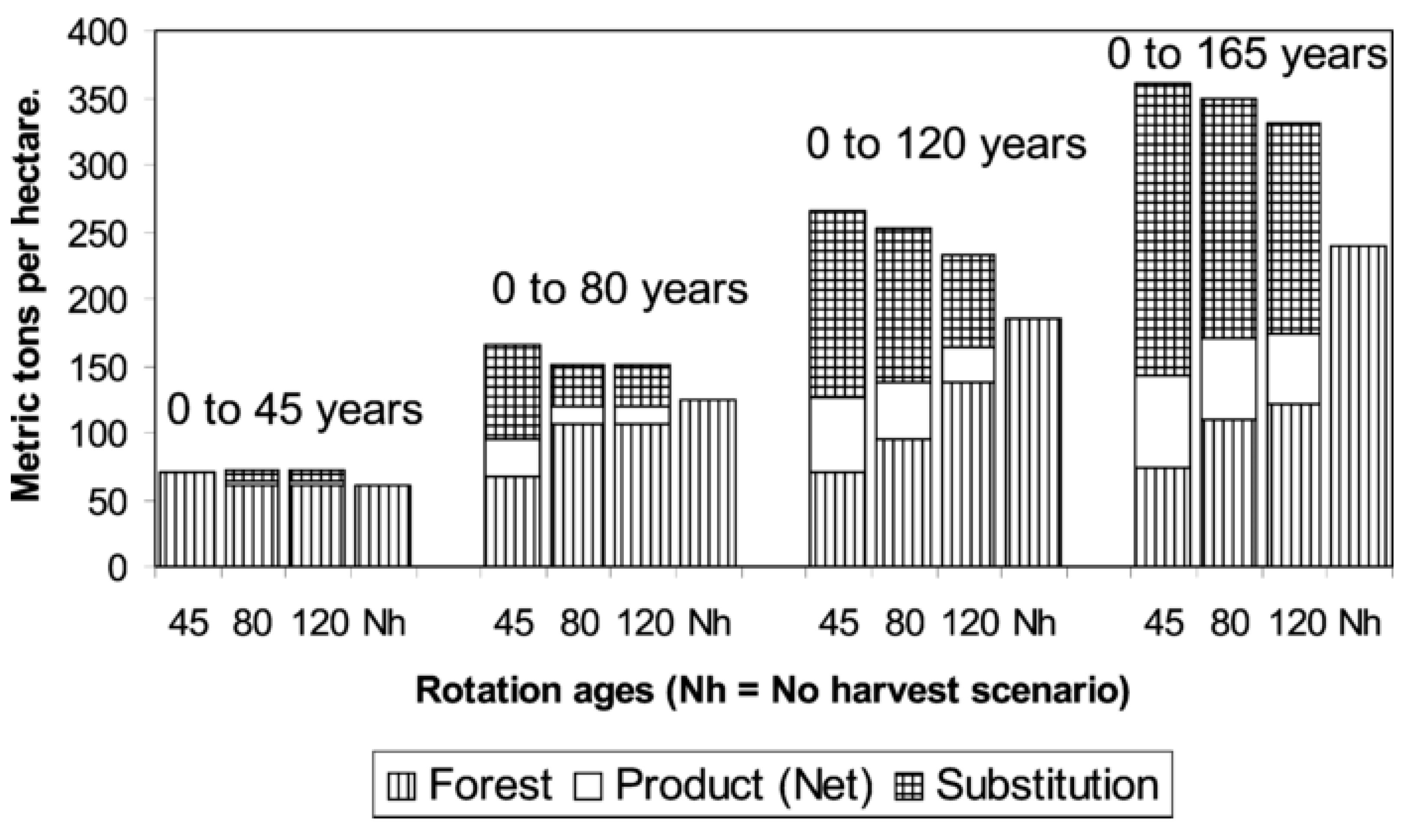
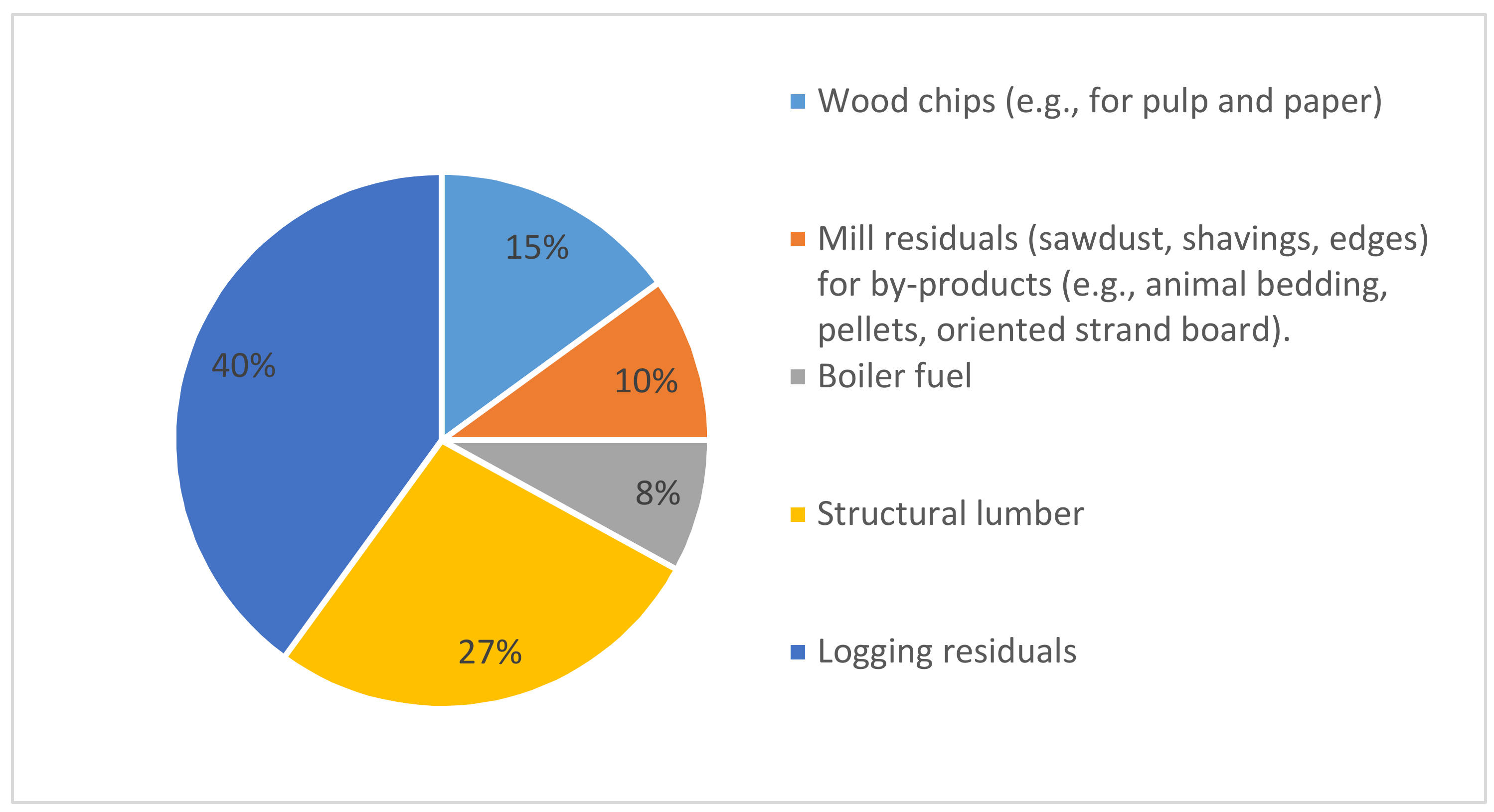
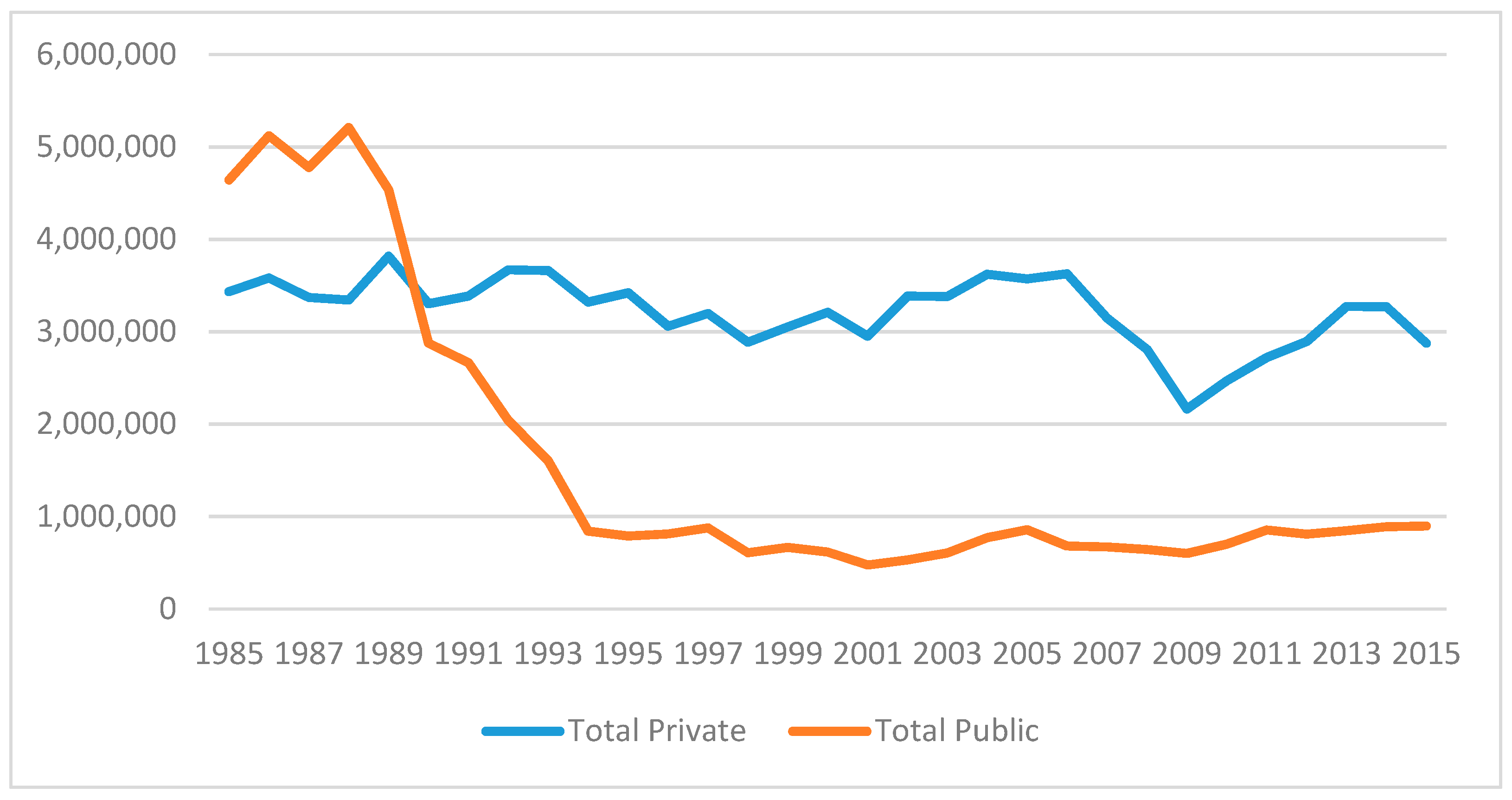
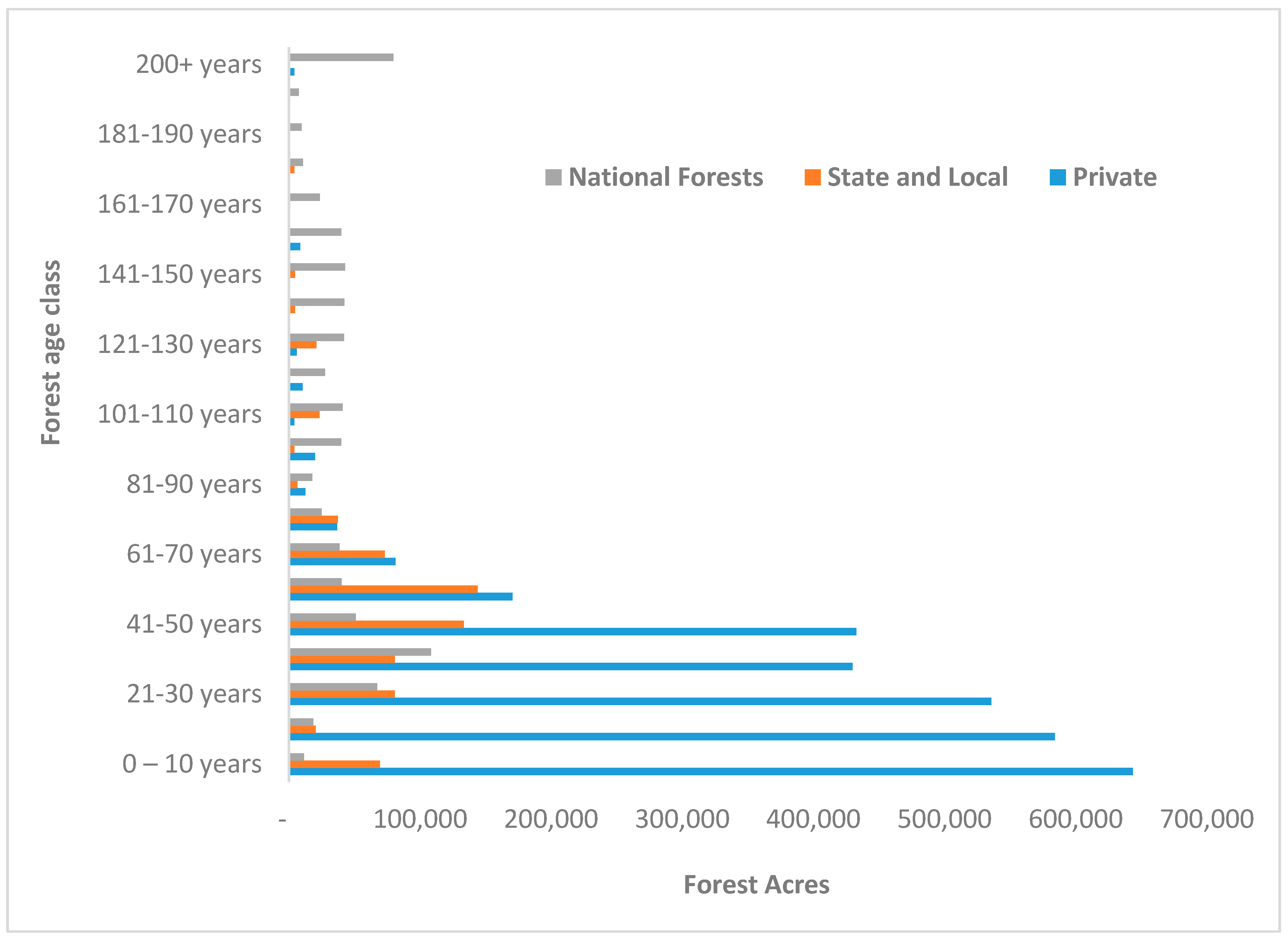
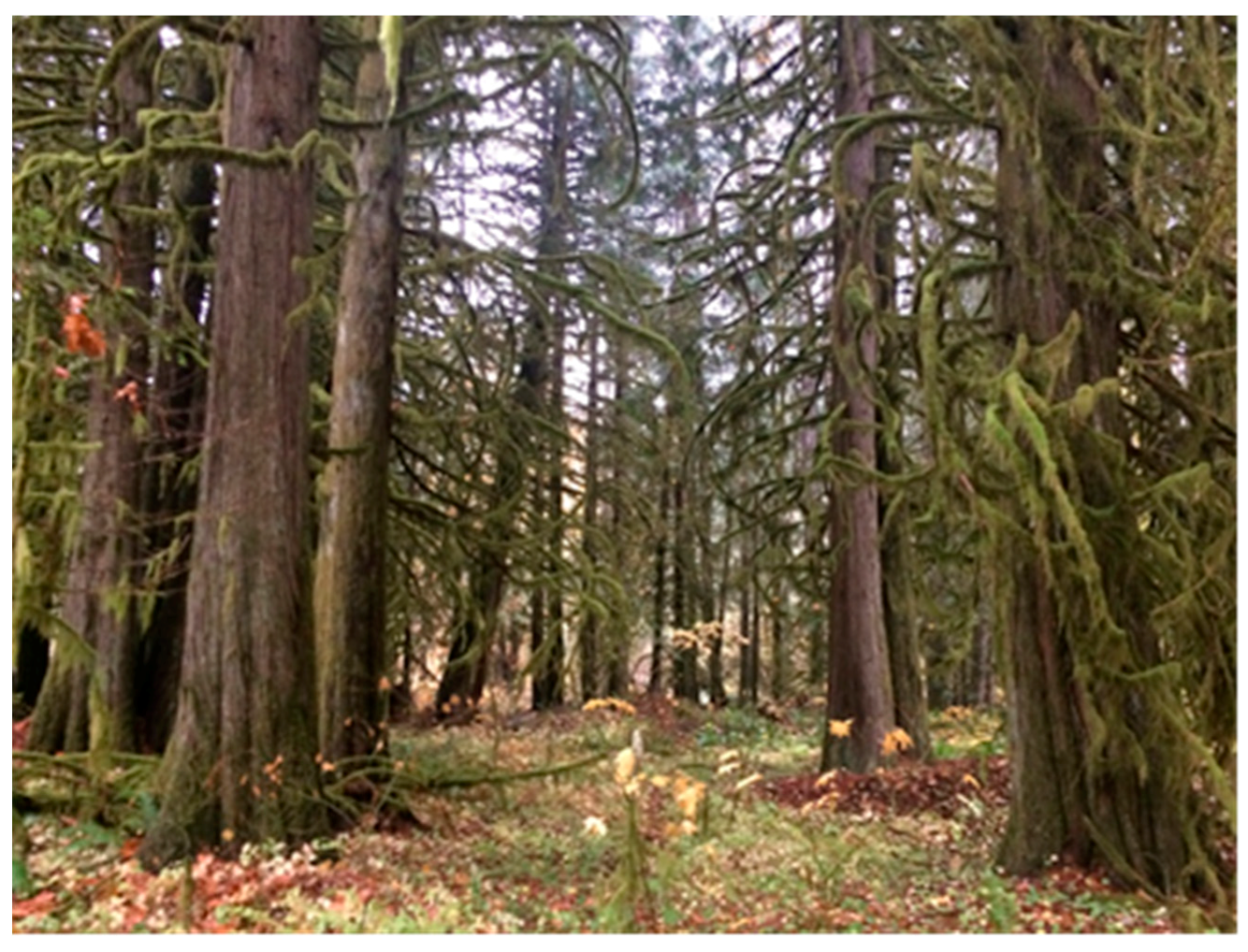
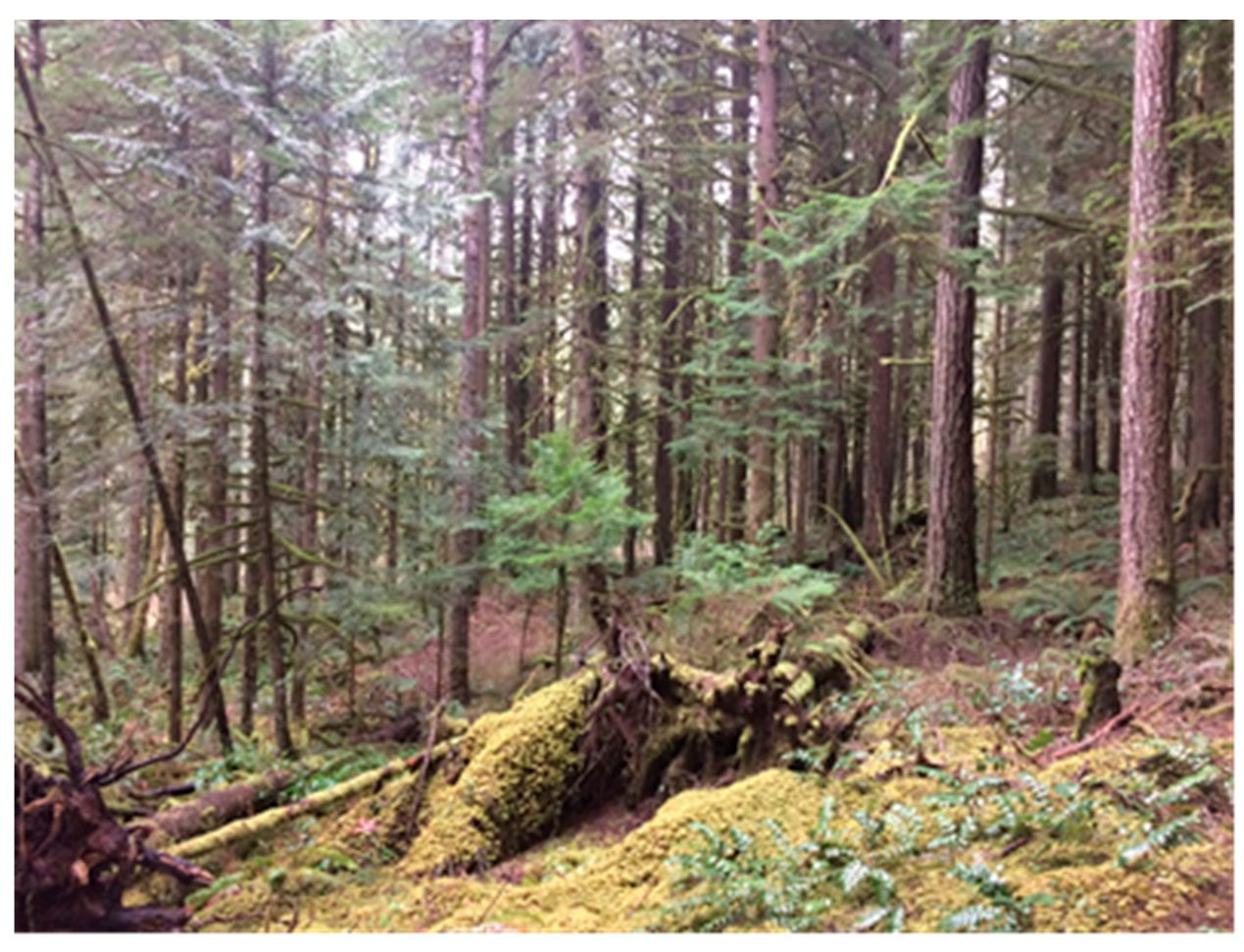
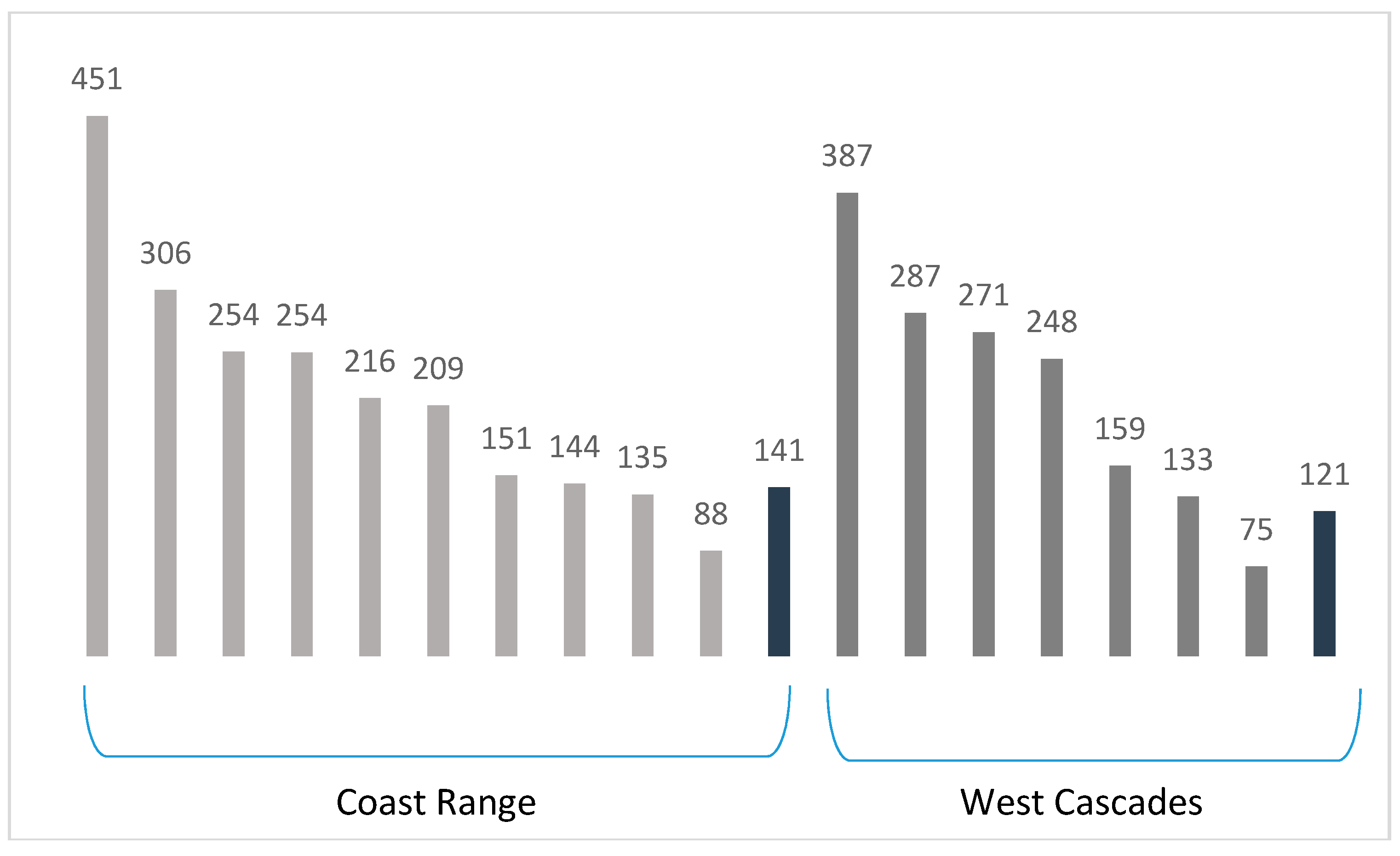
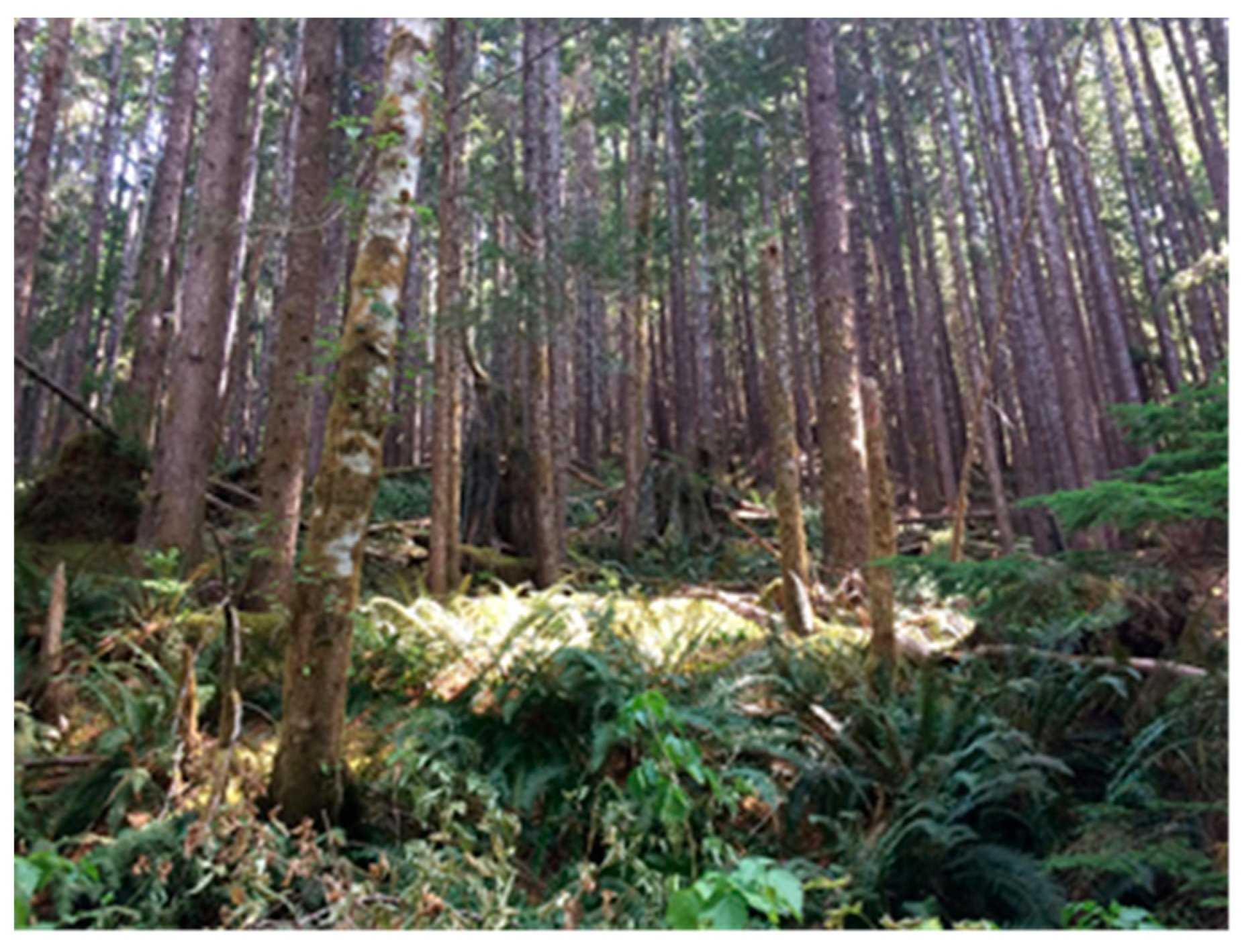
© 2018 by the authors. Licensee MDPI, Basel, Switzerland. This article is an open access article distributed under the terms and conditions of the Creative Commons Attribution (CC BY) license (http://creativecommons.org/licenses/by/4.0/).
Share and Cite
Fain, S.J.; Kittler, B.; Chowyuk, A. Managing Moist Forests of the Pacific Northwest United States for Climate Positive Outcomes. Forests 2018, 9, 618. https://doi.org/10.3390/f9100618
Fain SJ, Kittler B, Chowyuk A. Managing Moist Forests of the Pacific Northwest United States for Climate Positive Outcomes. Forests. 2018; 9(10):618. https://doi.org/10.3390/f9100618
Chicago/Turabian StyleFain, Stephen J., Brian Kittler, and Amira Chowyuk. 2018. "Managing Moist Forests of the Pacific Northwest United States for Climate Positive Outcomes" Forests 9, no. 10: 618. https://doi.org/10.3390/f9100618
APA StyleFain, S. J., Kittler, B., & Chowyuk, A. (2018). Managing Moist Forests of the Pacific Northwest United States for Climate Positive Outcomes. Forests, 9(10), 618. https://doi.org/10.3390/f9100618



